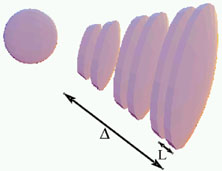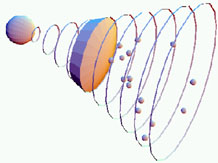


A. Internal vs. External Shocks
Consider a "quasi" spherical relativistic emitting shell with a
radius R, a width
 and a Lorentz
factor
and a Lorentz
factor  . This
can be a whole spherical shell or a spherical like section of a
jet whose opening angle
. This
can be a whole spherical shell or a spherical like section of a
jet whose opening angle  is larger than
is larger than
 -1.
Because of relativistic beaming an observer would observe
radiation only from a region of angular size
~
-1.
Because of relativistic beaming an observer would observe
radiation only from a region of angular size
~  -1.
Consider now photons emitted at different points along the shock
(see Fig. 18). Photons emitted by matter moving
directly towards the observer (point A in Fig. 18)
will arrive first. Photons emitted by matter moving at an angle
-1.
Consider now photons emitted at different points along the shock
(see Fig. 18). Photons emitted by matter moving
directly towards the observer (point A in Fig. 18)
will arrive first. Photons emitted by matter moving at an angle
 -1 (point
D in Fig. 18) would arrive after
tang = R / 2c
-1 (point
D in Fig. 18) would arrive after
tang = R / 2c
 2. This
is also, tR, the time of
arrival of photons emitted by matter moving directly towards the
observer but emitted at 2R (point C in
Fig. 18). Thus,
tR
2. This
is also, tR, the time of
arrival of photons emitted by matter moving directly towards the
observer but emitted at 2R (point C in
Fig. 18). Thus,
tR  tang
[94,
370].
This coincidence is the first part of the argument that rules out
external shocks in variable GRBs.
tang
[94,
370].
This coincidence is the first part of the argument that rules out
external shocks in variable GRBs.
 |
Figure 18. Different time
scale from a relativistic expanding shell in terms of the arrival
times (ti) of various photons:
tang = tD - tA,
tR = tC - tA and
t |
At a given point particles are continuously accelerated and emit
radiation as long as the shell with a width
 is crossing
this point. The photons emitted at the front of this shell will
reach the observer a time
t
is crossing
this point. The photons emitted at the front of this shell will
reach the observer a time
t =
=  / c before
those
emitted from the rear (point B in Fig. 18). In fact
photons are emitted slightly longer as it takes some time for the
accelerated electrons to cool. However, for most reasonable
parameters the cooling time is much shorter from the other time scales
[367]
and I ignore it hereafter.
/ c before
those
emitted from the rear (point B in Fig. 18). In fact
photons are emitted slightly longer as it takes some time for the
accelerated electrons to cool. However, for most reasonable
parameters the cooling time is much shorter from the other time scales
[367]
and I ignore it hereafter.
The emission from different angular points smoothes the signal on
a time scale tang. If
t
 tang
tang
 tR
the resulting burst will be smooth with a width
tang
tR
the resulting burst will be smooth with a width
tang  tR. The second part of this argument follows from the
hydrodynamics of external shocks. I show later in
Section VIC (see also Sari and Piran
[370])
that for external shocks
tR. The second part of this argument follows from the
hydrodynamics of external shocks. I show later in
Section VIC (see also Sari and Piran
[370])
that for external shocks
 / c
/ c
 R /
c
R /
c
 2
2
 tR
tR
 tang
and for a spreading shell
tang
and for a spreading shell

 R / c
R / c
 2. Therefore
external shocks can produce only smooth bursts!
2. Therefore
external shocks can produce only smooth bursts!
As we find only two time scales and as the emission is smoothed
over a time scale tang, a necessary condition for the
production of a variable light curve is that
t =
=  / c >
tang. In this case
t
/ c >
tang. In this case
t would be the duration of the burst
and tang the variability time scale. This can be easily
satisfied within internal shocks (see Fig 19).
Consider an "inner engine" emitting a relativistic wind active over a time
t
would be the duration of the burst
and tang the variability time scale. This can be easily
satisfied within internal shocks (see Fig 19).
Consider an "inner engine" emitting a relativistic wind active over a time
t =
=  / c
(
/ c
( is the overall
width of the flow in the observer frame).
The source is variable on a scale L / c. Internal shocks will
take place at
Rs
is the overall
width of the flow in the observer frame).
The source is variable on a scale L / c. Internal shocks will
take place at
Rs  L
L  2.
At this place the angular time and the radial time satisfy:
tang
2.
At this place the angular time and the radial time satisfy:
tang  tR
tR  L / c. Internal shocks continue as long as the source is
active, thus the overall observed duration T =
t
L / c. Internal shocks continue as long as the source is
active, thus the overall observed duration T =
t reflects the time that the "inner engine" is active. Note that now
tang
reflects the time that the "inner engine" is active. Note that now
tang  L / c <
t
L / c <
t is trivially satisfied. The observed variability time scale in the light
curve,
is trivially satisfied. The observed variability time scale in the light
curve,  t, reflects
the variability of the source L / c. While the overall
duration of the burst reflects the overall duration of the activity of
the "inner engine".
t, reflects
the variability of the source L / c. While the overall
duration of the burst reflects the overall duration of the activity of
the "inner engine".
Numerical simulations [193] have shown that not only the time scales are preserved but the source's temporal behavior is reproduced on an almost one to one basis in the observed light curve. This can be explained now [268] by a simple toy model (see Section VIB3 below).
 |
Figure 19. The internal shocks model (from
[364])
Faster. shells collide with slower ones and produce the observed
|
Clearly the way to get around the previous argument is if
tang < tR. In this case one can
identify tR with the duration
of the burst and tang as the variability time scale. The
observed variability would require in this case that:
tang / tR =
 t / T. For
this the emitting regions must be smaller than R /
t / T. For
this the emitting regions must be smaller than R /
 .
.
One can imagine an inhomogenous external medium which is clumpy
on a scale d << R /
 (see
Fig 20). Consider such a clump located at an angle
(see
Fig 20). Consider such a clump located at an angle
 ~
~
 -1 to the
direction of motion of the matter towards the observer. The
resulting angular time, which is the difference in arrival time
between the first and the last photons emitted from this clump
would be: ~ d / c
-1 to the
direction of motion of the matter towards the observer. The
resulting angular time, which is the difference in arrival time
between the first and the last photons emitted from this clump
would be: ~ d / c
 . Now
tang ~ d / c
. Now
tang ~ d / c
 <
tR and it seems that one can get around the argument
presented before.
<
tR and it seems that one can get around the argument
presented before.
 |
Figure 20. The clumpy ISM model (from [364]). Note the small covering factor and the resulting "geometrical" inefficiency. |
However, Sari and Piran
[370]
have shown that such a
configuration would be extremely inefficient. This third part of
this argument rules out this caveat. The observations limit the
size of the clumps to
d  c
c

 t and the
location of the shock to
R
t and the
location of the shock to
R  cT
cT
 2. The number
of clumps within the observed angular cone with an opening angle
2. The number
of clumps within the observed angular cone with an opening angle
 -1 equals
the number of pulses which is of the order
T /
-1 equals
the number of pulses which is of the order
T /  t. The
covering factor of the clumps can be directly
estimated in terms of the observed parameters by multiplying the
number of clumps (T /
t. The
covering factor of the clumps can be directly
estimated in terms of the observed parameters by multiplying the
number of clumps (T /
 t)
times their area d2 =
(
t)
times their area d2 =
( t
t
 )2 and
dividing by the cross section of the cone (R /
)2 and
dividing by the cross section of the cone (R /
 )2. The
resulting covering factor equals
)2. The
resulting covering factor equals
 t / T
<< 1. The efficiency of conversion of kinetic energy to
t / T
<< 1. The efficiency of conversion of kinetic energy to
 -rays in
this scenario is smaller than this covering factor which for a typical
variable burst could be smaller than 10-2.
-rays in
this scenario is smaller than this covering factor which for a typical
variable burst could be smaller than 10-2.
I turn now to several attempts to find a way around this result. I will not discuss here the feasibility of the suggested models (namely is it likely that the surrounding matter will be clumpy on the needed length scale [78], or can an inner engine eject "bullets" [162] with an angular width of ~ 10-2 degrees and what keeps these bullets so small even when they are shocked and heated). I examine only the question whether the observed temporal structure can arise within these models.
3. External Shocks on a Clumpy Medium
Dermer and Mitman
[78]
claim that the simple
efficiency argument of Sari and Piran
[370]
was flawed. They point out
that if the direction of motion of a specific blob is almost
exactly towards the observer the corresponding angular time will
be of order d2 / cR and not
d / c  used for a "generic" blob. This is narrower by a factor
d
used for a "generic" blob. This is narrower by a factor
d / R
than the angular time across the same blob that is located at a typical
angle of
/ R
than the angular time across the same blob that is located at a typical
angle of  -1.
These special blobs would produce strong narrow
peaks and will form a small region along a narrow cone with a
larger covering factor. Dermer and Mitman
[78]
present a numerical simulation of light curves produced by external shocks
on a clumpy inhomogeneous medium with
-1.
These special blobs would produce strong narrow
peaks and will form a small region along a narrow cone with a
larger covering factor. Dermer and Mitman
[78]
present a numerical simulation of light curves produced by external shocks
on a clumpy inhomogeneous medium with
 t / T ~
10-2 and efficiency of up to ~ 10%.
t / T ~
10-2 and efficiency of up to ~ 10%.
A detailed analysis of the light curve poses, however, several
problems for this model. While this result is marginal for bursts
with  t / T ~
10-2 with a modulation of 50% it is insufficient for bursts with
t / T ~
10-2 with a modulation of 50% it is insufficient for bursts with
 t / T ~
10-3 or if the modulation is ~ 100%. Variability on a time
scale of milliseconds has been observed
[269]
in many long GRBs (namely
t / T ~
10-3 or if the modulation is ~ 100%. Variability on a time
scale of milliseconds has been observed
[269]
in many long GRBs (namely
 t / T can
be as small as 10-4).
Moreover, in this case one would expect that earlier pulses (that
arise from blobs along the direction of motion) would be narrower
than latter pulses. This is not seen in the observed bursts
[328].
t / T can
be as small as 10-4).
Moreover, in this case one would expect that earlier pulses (that
arise from blobs along the direction of motion) would be narrower
than latter pulses. This is not seen in the observed bursts
[328].
Finally the arrival time of individual pulses depends on the position of the emitting clumps relative to the observers. Two following pulses would arise from two different clumps that are rather distant from each other. There is no reason why the pulses and intervals should be correlated in any way. Recall (Section IIA2) that the duration of a pulse and the subsequent interval are correlated [270].
Heinz and Begelman
[162]
suggested that the "inner engine" operates
as a shot-gun emitting multiple narrow bullets with an angular
size much smaller than
 -1 (see
Fig 21).
These bullets do not spread while propagating and they are slowed
down rapidly by an external shock with a very dense circumburst
matter. The pulses width is given by tang or by the
slowing down time. The duration of the burst is determined by the time
that the "inner engine" emits the bullets.
-1 (see
Fig 21).
These bullets do not spread while propagating and they are slowed
down rapidly by an external shock with a very dense circumburst
matter. The pulses width is given by tang or by the
slowing down time. The duration of the burst is determined by the time
that the "inner engine" emits the bullets.
 |
Figure 21. The shot-gun model (from [364]). The inner engine emits narrow "bullets" that collide with the ISM. |
This model can produce the observed variability and like in the internal shocks model the observed light curve represents also here the temporal activity of the source. However, in this model the width of the pulses is determined by the angular time or the hydrodynamic time or the cooling time of the shocked material. On the other hand the intervals between the pulses depend only on the activity of the inner engine. Again, there is no reason why the two distributions will be similar and why there should be a correlation between them (see Section IIA2 and [270]).
An interesting alternative to shocks as a way to dissipate kinetic
energy is within plasma turbulence
[226,
227,
387,
388].
It has been suggested that in this case the kinetic energy of the
shock is dissipated downstream to a combination of macroscopic
(relativistic) random motion of plasma blobs with a Lorentz factor
 b.
Within these blobs the particles have also a
(relativistic) random velocity with a Lorentz factor
b.
Within these blobs the particles have also a
(relativistic) random velocity with a Lorentz factor
 p,
such that:
p,
such that:
 s
s

 b
b
 p.
p.
Relativistic turbulence may be the only way to produce variability in a situation that the matter is slowed down by the external medium and not by internal interaction. I stress that in this case the process is not described by regular shocks and hence some of the previous arguments do not hold. Two crucial open questions are i) Whether one can produce the observed correlations between pulses and intervals. ii) Why there is no spreading of pulses at later times, as would be expected if the emitting region is slowing down and increasing its radius.